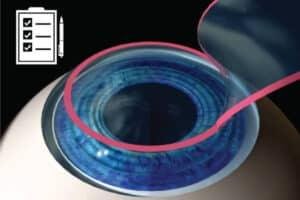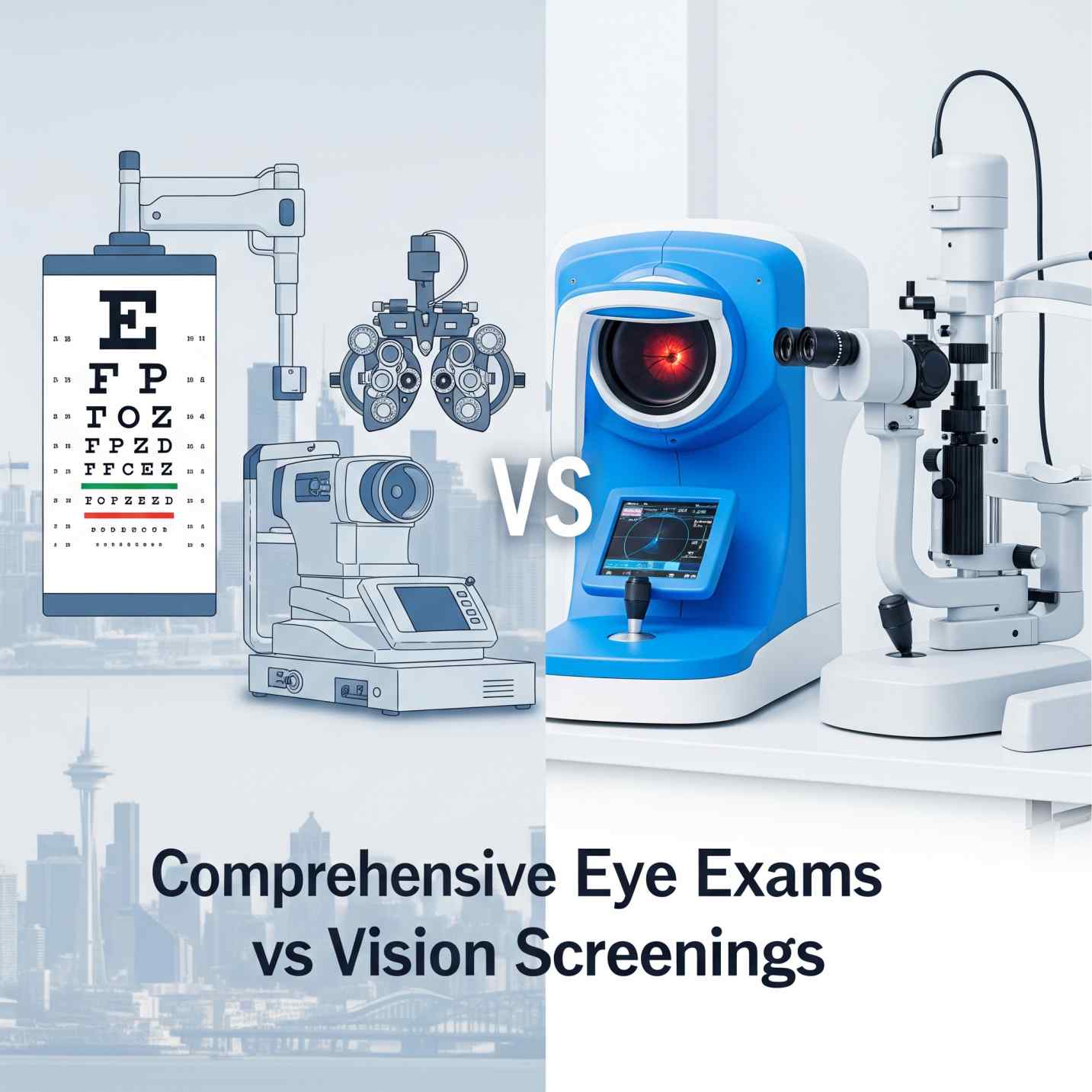LASIK Evaluations in Seattle – Refractive Surgery

Thinking about LASIK surgery? Discover how this quick, FDA-approved vision correction reshapes your cornea and frees you from glasses—permanently, in most cases.
Key Takeaways: LASIK Surgery Insights for 2025
-
You remain awake and alert during LASIK, helping the surgeon align the laser precisely with your visual target.
-
Blindness from LASIK is extremely rare, with most complications occurring in less than 1% of cases.
-
Dry eye is the most common side effect—pre-treatment and post-op care help reduce discomfort and improve results.
-
LASIK is a permanent procedure, but age-related vision changes like presbyopia may require reading glasses later in life.
-
Results often last 10+ years, especially for patients with stable prescriptions before surgery.
-
Avoid bargain LASIK providers, as surgical precision and safety depend heavily on surgeon expertise and advanced technology.
-
Follow-up care is essential—annual eye exams may be required to maintain eligibility for enhancements or warranties.
What is LASIK?
LASIK, the #1 vision correction surgery in the U.S. per the American Academy of Ophthalmology, is a 10-minute outpatient procedure trusted by Seattle clinics like Cannon EyeCare. Using FDA-approved lasers, board-certified surgeons reshape the cornea (the eye’s clear outer layer) to treat:
-
Nearsightedness (Myopia): Ideal for tech workers in South Lake Union battling screen-dependent blur.
-
Astigmatism: Corrects irregular corneal curvature, popular among Seattle athletes like Sounders FC players.
-
Hybrid Options: For mild farsightedness, Kirkland’s Evergreen Eye Center combines LASIK with PRK for enhanced results.
How LASIK Works at Seattle Clinics:
-
Numbing Drops: Eyes are anesthetized — no needles, minimal discomfort.
-
Corneal Flap Creation: A femtosecond laser creates a micron-thin flap (takes <30 seconds).
-
Reshaping: An excimer laser adjusts corneal curvature based on pre-op 3D mapping (Wavefront-guided at UW Medicine).
-
Recovery: 90% of Seattle patients resume work at Amazon or Microsoft within 24 hours.
How Much Does LASIK Seattle Cost?
LASIK surgery in Seattle typically ranges from 4,800 per eye, depending on technology (e.g., bladeless or Wavefront-guided) and surgeon expertise. Here’s what local patients should know:
Cost Breakdown:
-
Procedure Fees: Covers advanced laser technology, corneal mapping, and surgeon expertise.
-
Pre/Post-Op Care: Some clinics bundle pre-operative scans and 12-month follow-ups into total costs.
-
Payment Plans: Many Seattle providers offer 0% APR financing or accept HSA/FSA funds, ideal for tech professionals in South Lake Union or Boeing employees.
Insurance & Affordability:
-
Most insurers (e.g., Premera Blue Cross WA) classify LASIK as elective, but check with your HR department for employer-specific discounts.
-
Pro Tip: Ask about co-management agreements to streamline payments for surgery and follow-up care.
2024 Seattle-Specific Savings:
-
Seasonal promotions (e.g., “Seattle Sight Month” in November) often feature 600 discounts.
-
Military personnel, teachers, and first responders may qualify for reduced rates at select practices.
Key Consideration:
While LASIK isn’t covered by insurance, 92% of Seattle patients in a 2024 Pacific Northwest LASIK Study reported long-term savings from eliminating glasses/contacts.
Who Qualifies for LASIK in Seattle?
LASIK candidates in Seattle must meet specific criteria to ensure safe, effective results. Here’s what top surgeons evaluate:
Ideal LASIK Candidates:
-
-
Nearsightedness (-2.5 to -7.00 diopters), common among Seattle tech workers in South Lake Union offices.
-
Astigmatism under 3 diopters, often corrected for athletes training at Seattle’s Magnuson Park.
-
-
Stability: No prescription changes for 2+ years (verified via 3D corneal scans).
-
Age & Health:
-
25–35: Optimal for long-term results (e.g., UW students balancing studies and outdoor activities).
-
35+: Possible with healthy corneas — popular among Eastside professionals seeking screen-free convenience.
-
No active dry eye or conditions like keratoconus.
-
Seattle-Specific Factors:
-
Climate: Corneal thickness tests rule out rainy-season dryness impacting recovery.
-
Lifestyle: Ideal for hikers, cyclists, and boaters wanting glare-free vision on Puget Sound.
Free Consultation:
To find out if you are a LASIK candidate, schedule a consultation with Dr. Cannon. The medical practice Cannon EyeCare is located at Market Optical in Seattle’s University Village shopping center.
If you have any questions, please call our office at (206) 522-9323.
Before undergoing LASIK eye surgery, schedule a comprehensive preoperative evaluation at Cannon EyeCare, located in Seattle’s University Village. To help assess the stability of your vision, bring your last few pairs of glasses and any previous prescriptions. This step enables your eye doctor to determine whether your vision has remained consistent, an essential factor for LASIK candidacy. For additional tips, refer to our eye exam preparation guide.
The first pre-op visit closely resembles a standard eye exam. Most patients will need at least one follow-up appointment to confirm initial findings. At your second visit, expect pupil dilation and a cycloplegic refraction—a test that uses special eye drops to relax your focusing muscles. While this can temporarily blur your vision for up to 24 hours, it provides critical diagnostic insight.
Some candidates may first need treatment for underlying eye health conditions, such as blepharitis (lid inflammation caused by bacterial buildup) or dry eye syndrome, to optimize their outcomes. Fortunately, these preparatory visits are often covered by insurance.
Read More — How to prepare for your eye exam
Wearing Contact Lenses Before LASIK? Here’s What You Need to Know
If you wear contact lenses and are preparing for LASIK, it’s essential to understand how they can impact your corneal health. Contacts—particularly rigid gas permeable (RGP) lenses or poorly fitting soft lenses—can cause corneal swelling (edema) and irritation to the cornea and surrounding tissues. Additionally, contact lens solutions often contain harsh chemicals that, while designed to kill harmful microbes, may lead to ocular surface conditions like dry eye syndrome and keratitis.
Key takeaway: To ensure the most accurate LASIK assessment and best surgical outcome, discontinue contact lens use for at least one full week before each preoperative exam and the day of surgery. This simple step can significantly improve both diagnostic accuracy and surgical results.
Is LASIK Safe? Understanding the Risks and Realities
LASIK is widely regarded as a safe and effective procedure, but—like any surgery—it comes with potential risks. These may include:
-
Dry eyes
-
Glare and halos around lights, especially at night
-
Post-LASIK ectasia, a rare complication where the cornea gradually thins and bulges, possibly causing significant vision changes
Thanks to today’s advanced LASIK technology and experienced surgeons, severe side effects like ectasia are extremely rare.
Night vision issues are another consideration. Some patients experience glare when driving in low-light or rainy conditions. This is more common among younger individuals with naturally larger pupils, as light may enter through untreated areas of the peripheral cornea.
It’s also important to note that LASIK does not correct presbyopia—the age-related decline in near vision. This is why we advise patients in their 40s or older to expect they may still need reading glasses for up-close tasks, even after a successful LASIK procedure.
The LASIK Procedure: Step-by-Step Overview
LASIK surgery is performed in an ophthalmologist’s office and does not require an overnight stay. While the actual procedure takes just 15–20 minutes, plan to spend 3–5 hours at the surgery center for pre- and post-operative steps. Be sure to bring someone to drive you home, as your vision will be temporarily blurry afterward.
What to Expect on Surgery Day:
-
The support staff and technicians are available to assist you before and after the procedure.
-
You’ll be taken to the operating room, where you’ll lie down and follow detailed instructions from the surgeon.
-
You may hear clicking or humming sounds and possibly notice a burnt-hair smell—both normal.
After the Procedure:
-
Mild discomfort is common for a few hours and can be eased with medicated eye drops and non-preserved artificial tears.
-
Taking a nap after surgery is often recommended to aid recovery.
-
Since there are no stitches or bandages, you can return home shortly after the procedure.
-
Avoid rubbing your eyes, especially during the first 2–3 days. Rubbing too early can dislocate the corneal flap, which is a serious complication.
-
Be gentle for the first month when touching the eye area to prevent flap movement.
-
Refrain from smoking or using nicotine products during recovery, as it can slow healing and raise the risk of infection.
You’ll also receive instructions from your surgeon on how to properly use your medicated eye drops and artificial tears. Be sure to ask any questions before leaving the surgery center.
Post-Op Follow-Up Schedule:
-
1-day post-operative exam at the surgery center
-
1-week checkup with your optometrist
-
1-month follow-up if needed, based on healing and your surgeon’s assessment
If any complications arise, such as changes in flashes, floaters, or vision loss, seek care immediately. Though rare, retinal tears have been reported in myopic patients post-LASIK and require urgent attention.
Most patients resume normal activities within 24–36 hours, taking just two days off work: the day of surgery and the following day. read more

Am I Awake During LASIK Surgery?
Yes, you are awake during LASIK. The procedure requires you to be alert and focused, as the surgeon will ask you to look at a specific spot throughout the treatment. This ensures proper alignment and accuracy.
If you’re feeling nervous beforehand, inform the surgical staff. The surgeon—who is a licensed medical doctor (MD)—may recommend an in-office medication to help reduce anxiety safely.
Can LASIK Make Me Blind?
The risk of blindness from LASIK is extremely rare. The most commonly cited cause of post-LASIK vision loss is keratoconus, a condition that affects about 1 in 2,000 patients. It causes the cornea to steepen, which can result in severe nearsightedness, astigmatism, and increased sensitivity to light and glare.
Other rare but possible complications include:
-
Flap dislocation (often due to rubbing the eyes during recovery)
-
Infection
-
Inflammation
-
Corneal scarring
These complications occur in less than 1% of cases, especially when the procedure is performed by an experienced surgeon.
What are some common side effects of LASIK?
Your optometrist will do their best to get any dry eye disease under control before your surgery. Controlling this problem helps with the accuracy of the surgeon’s laser treatments as well as the ease of healing. This is because one of the most common side effects of refractive surgery is symptoms of dry eye. See your optometrist for help with managing dry eye. Please understand that any medical visits beyond the 30 days after surgery will likely be billed to insurance or paid out of pocket.
Is LASIK Surgery Permanent?
Yes, LASIK is a permanent vision correction procedure. However, it doesn’t guarantee you’ll never need glasses or contact lenses again. While most patients achieve long-lasting correction for distance vision, age-related changes in the eyes—particularly presbyopia—may require the use of reading glasses after age 44.
This is a normal part of the aging process and not a failure of the LASIK procedure itself.
How long do the results of LASIK last?
LASIK results typically last 10 years or more, especially if your prescription was stable before surgery. The long-term effectiveness of LASIK is most closely linked to how stable your vision was before undergoing the procedure.
That said, outcomes can vary. The precision of LASIK depends on the technology used and the skill of the surgeon, which is why we strongly discourage bargain procedures like those offered through Groupon.
The National Eye Institute recommends having regular follow-up exams every one to two years to monitor your refractive status. Many surgery centers also require annual eye exams to maintain eligibility for touch-up treatments under their surgical warranties.
Sincerely, Dr. Mark J. Cannon, Optometrist – Cannon EyeCare at Market Optical, Seattle, WA
FAQs
-
What is a LASIK evaluation and why is it necessary?
A LASIK evaluation is a comprehensive eye exam using advanced imaging and tests to determine if you’re a safe, suitable candidate for LASIK vision correction
-
How do I prepare for my LASIK evaluation?
-
What tests are done during a LASIK evaluation?
-
Who is a good candidate for LASIK surgery?
-
Will my eyes be dilated during the LASIK evaluation?
-
Can LASIK correct astigmatism or both near and distance vision?
-
How long does a LASIK evaluation take?
-
What happens if I have dry eyes during my LASIK evaluation?
-
Do I need to stop wearing contacts before the LASIK evaluation?
-
What should I bring to my LASIK evaluation?
-
How soon after my evaluation can I have LASIK surgery?
-
What risks or complications are discussed during the evaluation?

